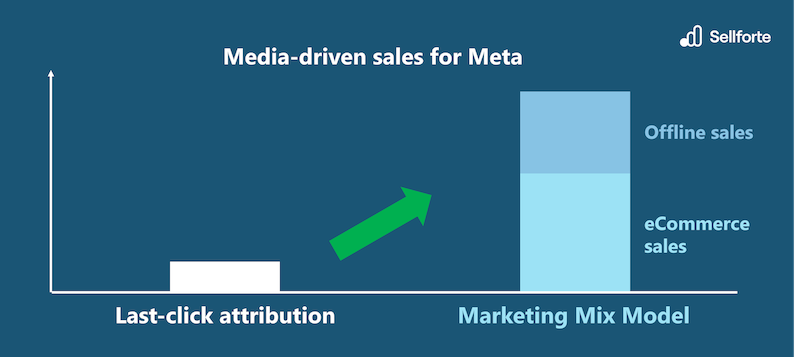The 3 Danger Zones of Last-Click (And How to Avoid Them)
If you're relying on Last-Click attribution to measure your marketing effectiveness, you might be flying blind.
Let’s start with a simple challenge: Open your Last-Click report. Pick a random campaign. Look at the ROAS.
Now ask yourself: Is this campaign truly driving incremental sales for your business?
Chances are, you can't say for sure. And that’s a problem.
What Are The 3 Danger Zones of Last-Click?
To uncover the typical danger zones of Last-Click attribution, we analyzed hundreds of campaigns for a major eCommerce brand, using Sellforte’s Marketing Mix Modeling (MMM) solution. We compared the ROAS from Last-Click Attribution to ROAS derived from Marketing Mix Modeling (MMM) in a 12-month time window. If you're not familiar with Marketing Mix Modeling take a look at our in-depth guide.
The key findings are visualized in the chart below. The axes were chosen so that we were able to fit 90% of the campaigns into the view, while enabling us to illustrate the danger zones for the readers of this blog. This means some of the long-tail campaigns showing really high ROAS do not appear in the visualization. Let's walk through the findings!
Firstly, we found out, that ROAS values from last-click and MMM were not correlated. This means:
- A high ROAS in your last-click dashboard doesn’t necessarily mean a campaign is driving new sales.
- A low ROAS doesn’t necessarily mean the campaign is underperforming.
In fact, we identified three danger zones where last-click can seriously mislead you—and your budget.

Last-Click ROAS vs. MMM ROAS by campaign for an eCom business
DANGER ZONE 1: Last-Click Overestimates ROAS
These campaigns look great in your Last-Click report. But MMM shows they’re not as effective as they seem. This happens because Last-Click tends to reward campaigns that are good at capturing existing demand, not creating new demand. These campaigns often steal credit for conversions that would have happened anyway.
Typical examples: Branded search campaigns, Retargeting campaigns.
The risk? You overinvest in these campaigns, leaving less budget for true growth drivers.
DANGER ZONE 2: Last-Click Underestimates ROAS
These campaigns look weak in Last-Click reports, but can actually deliver strong results. Why? Because these campaigns often initiate or are in the middle of the customer journey, but are not the last ads that are clicked before purchase. These campaigns can be great at driving new demand. But Last-Click rarely gives them proper credit.
Typical examples: Paid Social Prospecting, Meta Advantage+ campaigns
The risk? You underfund high-potential campaigns, missing out on scalable growth.
As an example, below is data from our earlier research, where we analysed typical multipliers that need to be applied to Google Analytics 4 Last-Click for different Meta channels to arrive at its true ROI. This data shows that you need to multiply Last-Click ROAS with 1.6-9.2x for Meta campaigns to arrive at its true effectiveness.
Meta Ads Incrementality Factors / Calibration mutlipliers for Google Analytics 4 last-click
DANGER ZONE 3: Last-Click Not Able to Measure ROAS
Last-Click shows zero conversions. So, cut the campaign, right? Wrong. This could be a costly mistake. Some channels don’t get any love from last-click attribution, even when they’re are driving significant amount of sales. These campaigms may not be clicked right before purchase , but they can still have high ROAS.
Typical campaigns not getting credit from Last-Click: YouTube campaigns, Facebook Awareness campaigns, TikTok campaigns.
The risk? You kill campaigns that are working—just because last-click can’t see their impact.
How to Avoid The Last-Click Danger Zones?
If you're still using last-click to measure ROAS, you’ve got a huge opportunity to improve your performance. With more advanced measurement, like MMM, you can:
✅ Uncover hidden winners in Zones 2 and 3
✅ Avoid overinvestment in Zone 1
✅ Make smarter budget decisions across the board
Video: Last-Click Danger Zones Explained
Conclusions
Ready to start measuring the true ROI of your campaigns with Sellforte? Start your Free Trial.
Further Reading
-
What is Marketing Mix Modeling? A Complete Guide. Link
-
From Last-click to Marketing Mix Modeling (MMM): Unlock +6.5% more sales. Link
-
How to measure Meta correctly? GA4 vs. MTA vs. MMM. Link
-
How to measure Meta correctly? Part 2: Add offline sales impact. Link
-
Advertising response curves: What are they and why do you need them? Link
-
How Much Ad Spend Is Needed for Marketing Mix Modeling? Link

You May Also Like
These Related Stories

